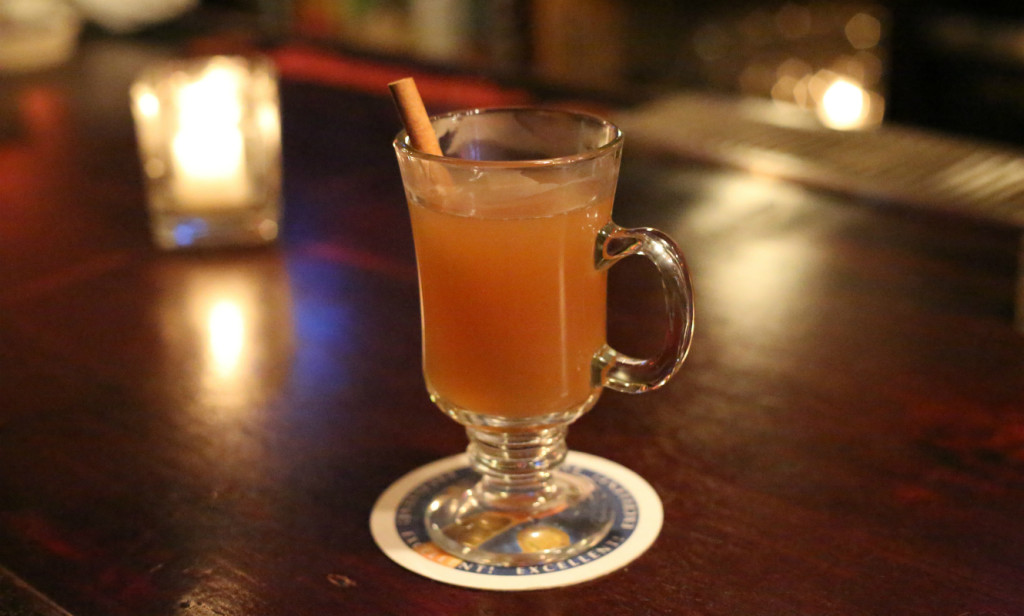“Jersey Lightning” Warms Up Winter Nights

In December 2007, I spent a week in London doing some archival and library research. I was staying on the Strand, and on my way to find a place to eat dinner after a particularly long day I stumbled across a hot cider stand at Covent Garden. The smell instantly drew me over on the crisp, cool night. I went over and ordered one, and the man working the stand asked if for an additional £2 I would like a shot of apple brandy added to the drink. After a long day, this sounded like a splendid idea. I stopped at that same stand at the end of each day for the remainder of that week, as I wended my way around, looking to find a different restaurant for dinner.
Ever since that December, when the weather cools, I very much like to have some hot cider with bit of a kick. For a time, I enjoyed using Calvados — the apple brandy originating in the Normandy region of France — but at $40+ a bottle this seemed like a bit of a waste. The draconian state liquor laws of the Commonwealth of Pennsylvania makes hard liquor only available through the state store system, which has a tendency to constrain selection and inflate prices. Then I discovered Laird’s Applejack, which is less than half the price of Calvados, and thus, a game changer.
Applejack was a mainstay alcoholic beverage of consumption in the colonial and post-independence eras, until the mid-19th century. Fears about potable water sources made alcoholic beverages the preferred drinks of that era. Plentiful apple supplies made cider a go-to component for fermentation. Applejack is made by allowing cider to ferment and then freezing it. The freezing removes excess water and leaves behind higher-proof alcohol. By freezing then thawing then freezing a spirit repeatedly, the alcohol content of a spirit increases markedly. This process is called jacking. The resulting applejack was known by some as “Jersey Lightning,” and was used as a form of payment in the 18th century.
Laird’s Applejack got its start when William Laird came to the colonies from Scotland in 1698. Their applejack was so popular that George Washington himself asked for their recipe in the mid-18th century, and was the only outsider able to secure the family’s formula. Laird’s son, Robert, went on to fight under Gen. Washington during the Revolutionary War. In 1780, he established America’s first and oldest commercial distillery in Scobeyville, New Jersey.
Over time, other forms of alcohol such as bourbon, whiskey, and rum became more popular. Laird’s is the only commercially available applejack in the United States today, though it is no longer freeze fermented. Modern applejack is made by mixing apple brandy with a neutral spirit (essentially vodka) and then aging it in bourbon barrels for a minimum of four years. The nice apple aroma makes it perfect for mixing with warm cider.
Two methods may be used to make Jersey Lightning Cider. You can either be ambitious and heat up some apple cider with cinnamon and other spices in a saucepan, and then add the applejack in later, or use this more expedient method:
Take one coffee mug and add 1–2 ounces of Laird’s Applejack to taste (rum or Calvados also work). Top off remainder of mug with apple cider (I prefer farmer’s market apple cider for a richer taste). Place mug in microwave and put on high for 90–120 seconds, depending upon how hot you like it. Remove from microwave, allow to cool to a drinkable temperature, and consume.
On a cold or cool winter’s night, few things are better than a mug of hot (spiked) apple cider.
Bonus Drink:
Should you have some Laird’s Applejack left over come summer, you can use it to make the Jack Rose Cocktail. This drink was popular in the 1920s and 1930s and made an appearance in Ernest Hemingway’s The Sun Also Rises. Its provenance is somewhat in dispute, with most saying that it first appeared in New Jersey or New York, but Harvey’s Famous Restaurant in Washington, DC, claims that it is an original of theirs. Furthermore, two WaPo writers famously traveled hither and yon throughout the District in 2003 looking for barmen who could make a Jack Rose, but were mostly unsuccessful (they only found one). Regardless, it makes a nice cocktail, particularly in the late summer/early fall.
Jack Rose
2 Oz. Applejack
1 Oz. Lime Juice
½ Oz. Grenadine
Chill a cocktail glass. Build all ingredients in a shaker tin. Add ice and shake for 15 seconds. Double strain into your chilled cocktail glass. Garnish with a lemon twist. The tartness of the lime juice (some prefer lemon juice) when combined with the apple flavor can be a nice change of pace.
As the eastern part of the United States is expecting snow this weekend, and possibly heavy snow in some areas, this might be a good time to try some Jersey Lightning Cider. Its warmth and delicious taste will fortify you for shoveling or venturing into the cold, or will serve as a nice treat to sip while curled up on the couch reading a book or binge watching a show such as Narcos. Cheers!
Michael P. Noonan, PhD, is the director of research at the Philadelphia-based Foreign Policy Research Institute and a contributor at War on the Rocks.
Photo credit: Timothy Krause

